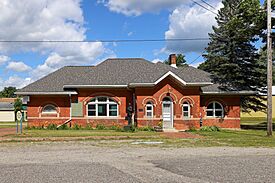Columbiaville, Michigan facts for kids
Quick facts for kids
Columbiaville, Michigan
|
|
|---|---|
|
Village
|
|
| Village of Columbiaville | |

The historic Columbiaville station
|
|

Location within Lapeer County
|
|
| Country | United States |
| State | Michigan |
| County | Lapeer |
| Townships | Marathon and Oregon |
| Settled | 1847 |
| Incorporated | 1879 |
| Government | |
| • Type | Village council |
| Area | |
| • Total | 1.18 sq mi (3.05 km2) |
| • Land | 0.88 sq mi (2.28 km2) |
| • Water | 0.30 sq mi (0.77 km2) |
| Elevation | 771 ft (235 m) |
| Population
(2020)
|
|
| • Total | 702 |
| • Density | 797.73/sq mi (308.01/km2) |
| Time zone | UTC-5 (Eastern (EST)) |
| • Summer (DST) | UTC-4 (EDT) |
| ZIP code(s) |
48421
|
| Area code(s) | 810 |
| FIPS code | 26-17460 |
| GNIS feature ID | 0623646 |
Columbiaville is a small village in Lapeer County, Michigan, in the United States. In 2020, about 702 people lived there. The village is located along the Flint River. Most of Columbiaville is in Marathon Township, with a small part extending into Oregon Township.
Contents
History of Columbiaville
Early Settlers and Naming
The first person to settle in the area that became Columbiaville was Levi D. Cutting. He was a carpenter and cabinet maker. He arrived with his family in 1847. His old home is still standing today.
In 1848, George and Henry Niver built a saw mill by the Flint River. This made the area known as "Niverville." William Peter, a friend of the Nivers from Columbia County, New York, came to work at the mill. By 1852, he started his own store. Eventually, he owned most of the land in Columbiaville.
A post office was opened in April 1857. The Nivers wanted to name the place "Columbia" after their home county. But there was already another post office in Michigan with that name. So, they decided on "Columbiaville" instead.
Growth and Development
The village continued to grow. William Peter built a large mill for grinding grain. In 1872, the Detroit and Bay City Railroad built tracks through Columbiaville. The first train station was made of wood. Later, in 1893, William Peter built a brick station. He made sure that all passenger trains would stop in Columbiaville. The railroad helped the village a lot by making transportation easier.
In 1892, William Peter and his workers built the William Peter Mansion. It had sixteen rooms! The Peters moved into the mansion in 1896. Mrs. Peter liked that their home was right in the center of the village. William Peter passed away in 1899 at age 75.
Modern Times Begin
The first car arrived in Columbiaville in 1903. Not everyone liked it at first! The first gas station opened in the early 1900s. Later, in the 1920s, people like Roy Osborne and Thomas Ward opened car dealerships and garages.
Geography of Columbiaville
Columbiaville covers a total area of about 1.15 square miles (3.0 square kilometers). About 0.85 square miles (2.2 square kilometers) is land, and 0.30 square miles (0.77 square kilometers) is water.
Population Facts
| Historical population | |||
|---|---|---|---|
| Census | Pop. | %± | |
| 1880 | 326 | — | |
| 1890 | 578 | 77.3% | |
| 1900 | 457 | −20.9% | |
| 1910 | 369 | −19.3% | |
| 1920 | 656 | 77.8% | |
| 1930 | 477 | −27.3% | |
| 1940 | 664 | 39.2% | |
| 1950 | 789 | 18.8% | |
| 1960 | 878 | 11.3% | |
| 1970 | 935 | 6.5% | |
| 1980 | 953 | 1.9% | |
| 1990 | 934 | −2.0% | |
| 2000 | 815 | −12.7% | |
| 2010 | 787 | −3.4% | |
| 2020 | 702 | −10.8% | |
| U.S. Decennial Census | |||
Population in 2010
In 2010, there were 787 people living in Columbiaville. There were 299 households, which are groups of people living together. Most people were White (95.2%). A small number were from other backgrounds. About 4.6% of the population was Hispanic or Latino.
About 35.5% of households had children under 18 living with them. Many households (48.5%) were married couples. The average age in the village was 36.4 years old. About 27.1% of residents were under 18.
See also
 In Spanish: Columbiaville para niños
In Spanish: Columbiaville para niños



